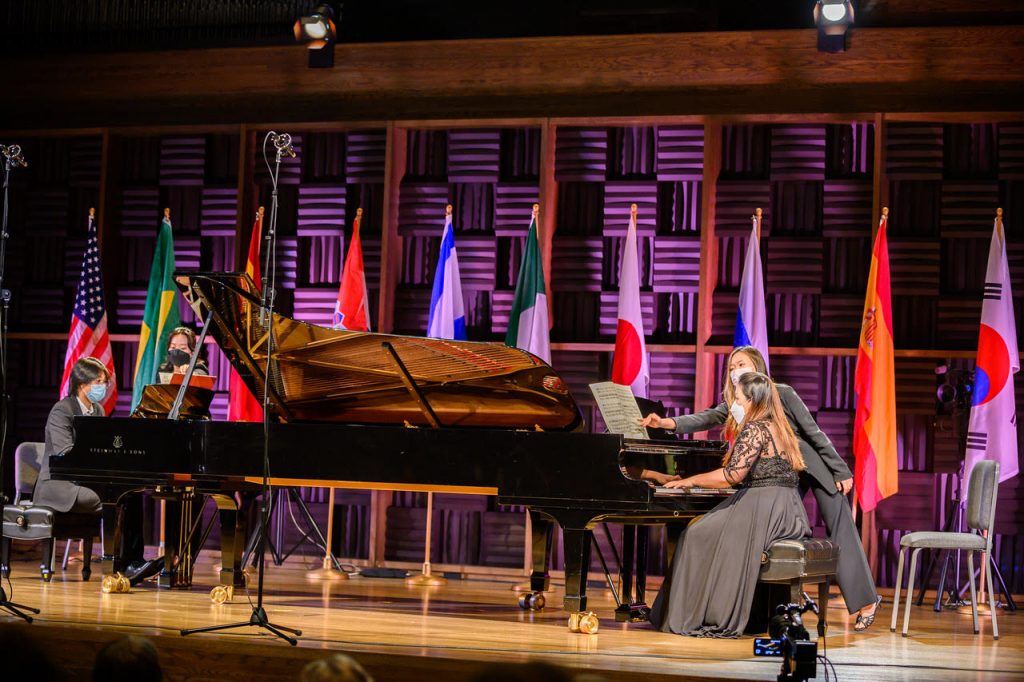by Daniel Hathaway

22-year-old Jiarui Cheng, born in Nanjing, China and now pursuing a degree with Kathryn Brown at the Cleveland Institute of Music after studies at the Shanghai Conservatory’s Middle School, crafted an engaging playlist with a built-in crescendo of musical intensity.
He began by quietly capturing our attention with an introspective Scarlatti Sonata, then took us on an eventful boat ride via a Chopin Barcarolle, and ended (almost — there was more to come) with Rachmaninoff’s kaleidoscopic Corelli Variations.
Domenico Scarlatti’s little two-page Sonata in b, K. 87 stands out among the composer’s 555 keyboard works for its expressive counterpoint — a four-voice texture that moves in and out of harmonic conflict and resolution like the meandering thoughts of a brooding improviser, only breaking the polyphonic texture in the last few measures of each half. In spirit, it closely resembles the b-minor prelude in The Well-Tempered Clavier I. Cheng played it with exquisite voicing and such expressive intimacy that you almost felt you were eavesdropping on a private practice session.
Although Chopin gently launches his boat on inland waterways in the Barcarolle in F-sharp, Op. 60, the vessel gradually heads out to encounter the more consequential waves of the open sea — continuing the notion of a programmatic crescendo. Cheng was alert to each incremental change in the musical narrative, guaranteeing a riveting journey.
After its original statement, Corelli’s theme in Rachmaninoff’s Op. 42 Variations returns from time to time like an ear worm in a technicolor dream. Just when the composer has ventured too far out on a limb, the reason for the piece re-emerges, sometimes reharmonized, sometimes in a parody of itself. Cheng demonstrated his mastery of the work’s structure in his pacing and carried the listener along with his flawless technique. His range of dynamics was impressive,
More to come? Cheng ended his set with Alexey Kurbatov’s shamelessly dazzling arrangement of Leonard Bernstein’s “America” from West Side Story, a song that can instantly explain the rhythmic figure of the hemiola to the uninitiated.

In designing her program, Kim bravely took on two works that have posed challenges for their composers, interpreters, and audiences alike.
The very title, Polonaise-Fantaisie in A-flat, Op. 61, suggests indecision on Chopin’s part. Can the military character of the polonaise and the freewheeling nature of the fantasy inhabit the same musical space? Kim wanted the answer to be ‘yes,’ but didn’t get much help from the composer, who seemed unable to reconcile the two. Liszt’s comment that the piece was like “somebody caught in an ambush, surrounded on all sides” rings all too true.
Prokofiev’s Sonata No. 4 in c, Op. 29, the last he wrote before leaving Russia and based on sketches from his conservatory days, spends its first two movements brooding in dark colors — perhaps recalling the suicide of a friend — before showing signs of the composer’s signature mischievousness in the finale. Yedam Kim has the chops to meet all of Prokofiev’s technical demands, and she finally took the opportunity to demonstrate that once the dark clouds had passed.
Alexei Kurbatov’s thick-textured arrangement of Freddie Mercury’s Bohemian Rhapsody brought Kim’s set to a close. After a 15-minute pause to position a second Steinway, she joined Cheng in a welcomely bright performance of Mozart’s D-Major Sonata. Positioning the pianos head-to-tail rather than cheek-to-cheek complicated the coordination of the sixteenth-note runs that make the piece so lively, and some over-pedaling occasionally blurred textures, but the two keyboardists merged their performing personalities far more successfully than Chopin had reconciled the polonais and the fantasy.
Published on ClevelandClassical.com July 30, 2021.
Click here for a printable copy of this article





